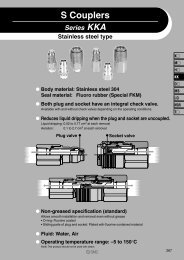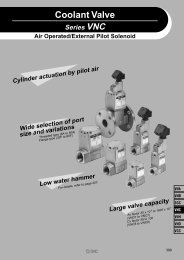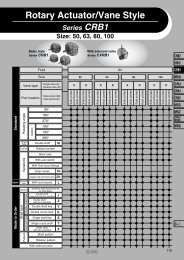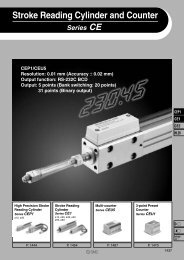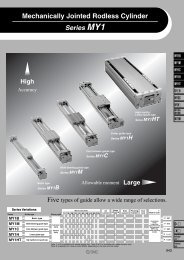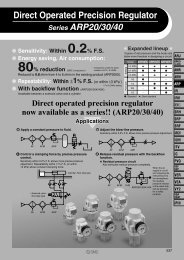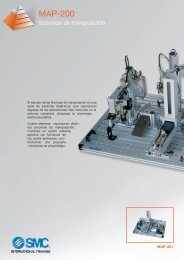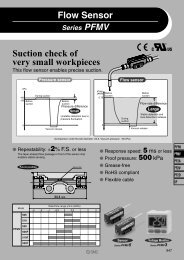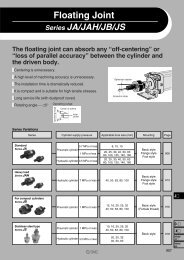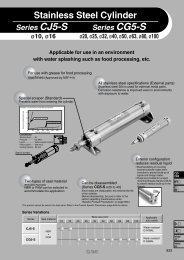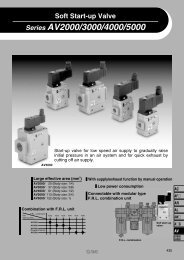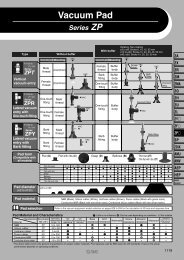Sintered Metal Element - SMC
Sintered Metal Element - SMC
Sintered Metal Element - SMC
You also want an ePaper? Increase the reach of your titles
YUMPU automatically turns print PDFs into web optimized ePapers that Google loves.
<strong>Sintered</strong> <strong>Metal</strong> <strong>Element</strong><br />
Specific Product Precautions 1<br />
Be sure to read before handling.<br />
Caution<br />
1. Tensile strength<br />
The elements are made of porous material with voids inside.<br />
Therefore their tensile strength compared to conventional<br />
stainless steel or bronze products is lower by a factor of one<br />
or two magnitudes. Depending on the application conditions,<br />
reinforcing material may be required. Use punched metal or<br />
similar for reinforcement.<br />
2. Operating temperature<br />
The operating temperature range given in the specifications<br />
(page 842) is the range in which material strength does not<br />
deteriorate significantly.<br />
In an oxidizing atmosphere (atmospheric air), the temperature<br />
point where oxidization and discoloring begins is 100°C<br />
for bronze elements and 250°C for stainless steel elements.<br />
3. Wrench sleeve<br />
For elements equipped with a fitting, provide a wrench sleeve<br />
at the fitting. If the element is grasped directly with a tool, the<br />
element may be damaged or destroyed.<br />
4. Fatigue breakdown<br />
Fatigue breakdown may occur under the following conditions:<br />
1) <strong>Element</strong> is subject to vibrations<br />
2) <strong>Element</strong> is subject to cyclic thermal expansion and contraction<br />
In such cases, use suitable countermeasures such as vibration<br />
dampers or punched metal reinforcements to support the<br />
element, or employ a construction that absorbs thermal expansion<br />
and contraction.<br />
5. End configuration<br />
For information on end configurations of cylinder elements<br />
(open or with bottom), check the notes and configuration information<br />
on the page for the respective product in this catalog.<br />
When devising applications, make sure that there are no<br />
problems such as improper sealing or leaks due to the end<br />
configurations.<br />
6. Particle separation<br />
When cutting is performed, particle chipping will occur at<br />
edge sections. This is especially noticeable with products<br />
rated for high nominal filtration accuracy (µm) values. Particle<br />
chipping and other machining problems may also occur at<br />
edges of products that are not finished by cutting. Carefully<br />
check sealing properties before use.<br />
7. Welded products (Stainless steel elements)<br />
Welded stainless steel elements are produced by argon<br />
welding. Consequently, problems such as uneven height, distortion,<br />
warping, raised beads etc. may be present.<br />
Discoloration of sections exposed to heat may not be completely<br />
removed by cleaning.<br />
8. Cleaning<br />
<strong>Sintered</strong> metal elements are cleaned before shipping, but not<br />
to clean room standards. Before use in a clean room, elements<br />
must be cleaned and flushed by the customer, and application<br />
suitability must be verified.<br />
Precautions on Design<br />
Bronze element<br />
Stainless steel<br />
element<br />
Corrosion caused by hydrogen sulfide (H2S) and sulfurous<br />
acid (SO2)<br />
Atmosphere<br />
Products have some resistance but long-term use will<br />
Sea water<br />
cause corrosion<br />
Fresh water Corrosion caused by presence of carbonic acid (carbonation)<br />
Stainless steel elements<br />
Category Corrosive substances and corrosion conditions<br />
Sulfur, hydrochloric acid, etc.<br />
Corrosion may be accelerated by density, temperature,<br />
halogen (especially chlorine) ion content, etc.<br />
Nitric acid<br />
Acid,<br />
Compared to sulfur, hydrochloric acid etc., resistance is better due<br />
alkali, etc. to passivity, but under certain conditions, corrosion may occur.<br />
Corrosion due to sodium hydroxide and potassium hydroxide<br />
Corrosion will be intensified by introduction of dissolved oxygen<br />
Atmosphere<br />
Sea water<br />
Oxide bath Anti-corrosive<br />
→ Note)<br />
cleaning treatment<br />
Oxide bath →<br />
Passivation<br />
Welded products<br />
cleaning (Nitric acid bath)<br />
Passivation<br />
Non-welded<br />
(Nitric acid bath)<br />
finished products<br />
Non-welded nonfinished<br />
Freon ultrasonic cleaning<br />
products<br />
Note) Anti-corrosive treatment is not intended to provide corrosion resistance<br />
during use or long-term storage capability. It is a simple treatment<br />
intended to prevent discoloration.<br />
Products with nominal filtration accuracy of 2 to 10 micron and 5 t or<br />
higher may exhibit discoloration by oxide bath cleaning.<br />
9. Corrosion<br />
Note that corrosion will occur, depending on usage and ambient<br />
conditions. Major corrosive substances and corrosion<br />
conditions are listed below. Be sure to check this information.<br />
Bronze elements<br />
Category Corrosive substances and corrosion conditions<br />
Acid,<br />
alkali<br />
Use in nitric acid, sulfur, and hydrochloric acid not possible,<br />
due to corrosion<br />
Use in solutions with ferric or cupric ion content or ammonium<br />
content not possible, due to corrosion<br />
Sodium chloride, sodium bromide etc.<br />
Corrosion caused by CO2, SO2, NH3 etc. in the atmosphere,<br />
and by temperature and other atmospheric conditions<br />
Corrosion depending on chlorine ion content, dissolved<br />
oxygen content, and organic matter<br />
Fresh water<br />
Corrosion caused by halogen (especially chlorine) ion content, deposits, etc.<br />
Corrosion caused by presence of carbonic acid (carbonation)<br />
High-temperature<br />
water<br />
Corrosion is accelerated at higher temperatures<br />
Steam Corrosion is accelerated at higher temperatures<br />
10.Discoloration<br />
<strong>Element</strong>s are processed with a simple anti-corrosive treatment<br />
to prevent discoloration, but this is not intended to provide<br />
long-term storage properties. After use, discoloration can<br />
be caused by foreign matter deposits, oxidization by flow medium,<br />
and other conditions.<br />
With bronze elements in particular, moisture in the atmosphere<br />
will lead to the formation of a dark red CuO film. Discoloration<br />
after use is to be considered unavoidable.<br />
853<br />
FGD<br />
FGE<br />
FGG<br />
FGA<br />
FGB<br />
FGC<br />
FGF<br />
FGH<br />
EJ<br />
ED<br />
FQ1<br />
FN<br />
EB<br />
ES




